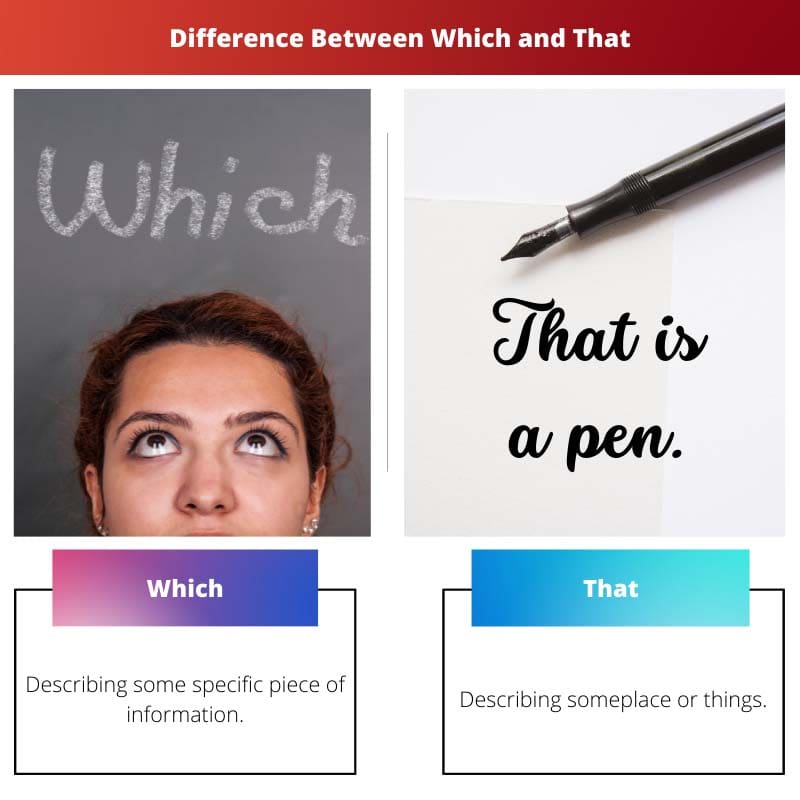Having the correct use of words is very important when we speak or when we write. If we use improper words, then the entire meaning will change when we convey the message to another person.
The two connecting words are different and are used in different places depending on the situation.
Key Takeaways
- “Which” is used for non-restrictive clauses, adding extra information without changing the sentence’s meaning, whereas “that” provides essential information to define the subject.
- “Which” is preceded by a comma, while “that” is not.
- “Which” is more common in British English, whereas “that” is preferred in American English.
Which vs That
The difference between Which and That, is people use which when they use non-defining clauses in their sentence. On the other hand, people use that when they use defining clauses in their sentences. Also, which is used for adding some specific sort of information, but that is used only for indicating information.

Which is used for asking questions and also for describing things. This word contains some rules, and you have to follow them while speaking to avoid mistakes in your sentences.
For that, you can find many resources and start practising them so that you will start to find the difference. This will help you to speak better English.
The usage of That is dependent on when we indicate something. But when we indicate some things plural, we should avoid using that and instead switch to the plural word those.
But often, people confuse themselves while using which and that, and it can be identified with the help of clauses.
Comparison Table
| Parameters of Comparison | Which | That |
|---|---|---|
| Language used | English | English |
| Used for | Describing some specific piece of information | Describing someplace or things |
| Main usage | Specific thing | People or things |
| Clause | Non-defining clause | Defining clause |
| Parts of speech | Adjective | Pronoun, conjunction, and adverb |
What is Which?
Which is a word that is used in English. This is used in many conversations, and many people use it in their daily life. It is used by people to ask something or to clear their doubts.
There are some rules available in English to use that. We can use which randomly in a conversation. Or we can’t simply replace it with some other word because that will make the conversation meaningless.
It comes under the adjective. The adjective comes under the parts of speech. Parts of speech are grammar, and everyone should follow the rules in them so that they can use them correctly when they use any words related to it.
They can be learned fast by using them daily. But we should avoid using them deliberately to learn a language. If we are finding it difficult to understand, then we can find many resources online which provide more information on where to use and where not to.
So, that it will give you a piece of clear information and you can understand it as well. Which is also used in non-defining clauses. But this word is used for describing things, and we cannot use this word for describing people. It won’t be proper.
Even singular and plural also play some role in using this. So, before using it in a sentence, you should have studied all the rules so that you can use them without any mistakes.

What is That?
That is an English word that is used to denote something. It can be used in many parts of speech. But there are some rules to be followed before using that. In grammar, everything comes with rules.
You cannot use words without having proper grammar because there won’t be proper meaning in that sentence. It can even be used at the beginning of the sentence as well by the speaker.
The main motive behind using this word is to tell something to the other person by denoting that word. But if you want to use that in the plural, then you have to switch over to another word. Because you can’t use that directly in sentences in the plural.
The most common problem many people make is they confuse the sentence with that and it. They don’t know when to use that and it. This will become a practice once you start learning or speaking.
By doing this, you will start making mistakes initially. But those mistakes will be corrected. Soon you will find yourself speaking properly. Once when you start using them in your regular sentences soon, you will be able to get the hang of it.
It also has a friend called This. This is also used to describe, denote, and indicate something. But it depends on the kind of object and where we are using it.

Main Differences Between Which and That
- We use the word Which when we have any non-defining clause in the sentence. On the other hand, we use That when we have any defining clause in the sentence.
- Which is used for adding specific sorts of information. On the other hand, That is used for describing or indicating things around us.
- Which is used as an adjective in parts of speech. But That is used in many parts of speech. It is hard to define.
- The word Which is used for describing a thing. But That can be used for both things and the people around us.
- We use the word Which is used in the non-restrictive relative clauses. On the other hand, the word That is used for the restrictive relative clause.




